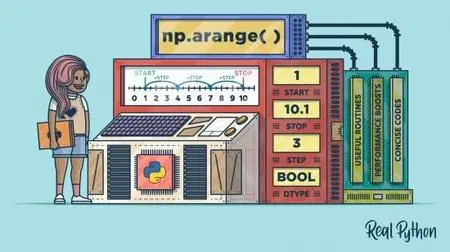Using NumPy's np.arange() Effectively
MP4 | Video: h264, 1920x1080 | Audio: AAC, 44.1 KHz, 2 Ch
Genre: eLearning | Language: English | Duration: 6 Lessons (28m) | Size: 92.2 MB
MP4 | Video: h264, 1920x1080 | Audio: AAC, 44.1 KHz, 2 Ch
Genre: eLearning | Language: English | Duration: 6 Lessons (28m) | Size: 92.2 MB
NumPy is the fundamental Python library for numerical computing.
NumPy is the fundamental Python library for numerical computing. Its most important type is an array type called ndarray. NumPy offers a lot of array creation routines for different circumstances. arange() is one such function based on numerical ranges. It’s often referred to as np.arange() because np is a widely used abbreviation for NumPy.
Creating NumPy arrays is important when you’re working with other Python libraries that rely on them, like SciPy, Pandas, Matplotlib, scikit-learn, and more. NumPy is suitable for creating and working with arrays because it offers useful routines, enables performance boosts, and allows you to write concise code.
By the end of this course, you’ll know:
What np.arange() is
How to use np.arange()
How np.arange() compares to the Python built-in class range
Which routines are similar to np.arange()
Let’s see np.arange() in action!



